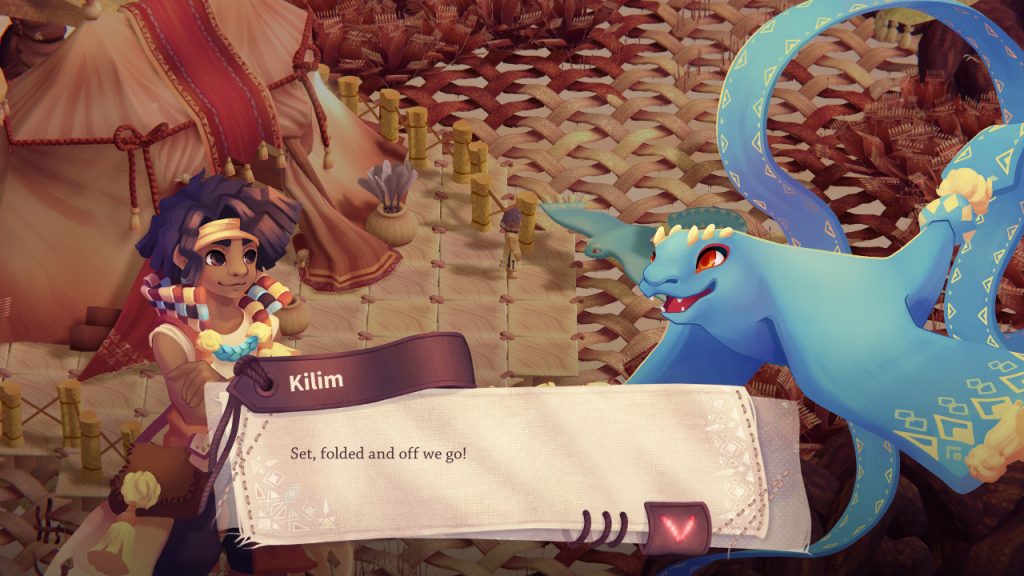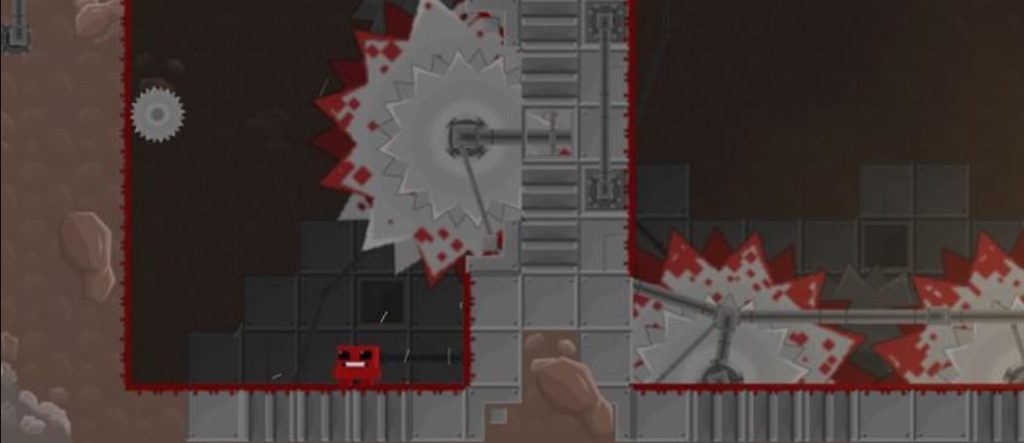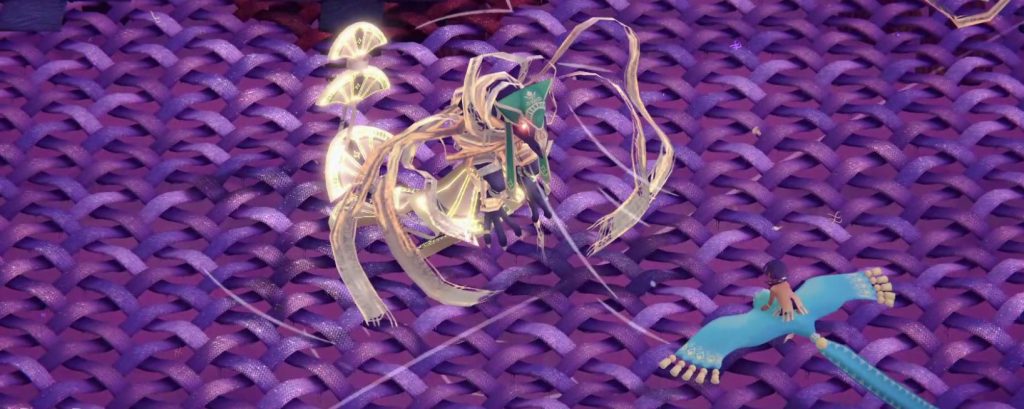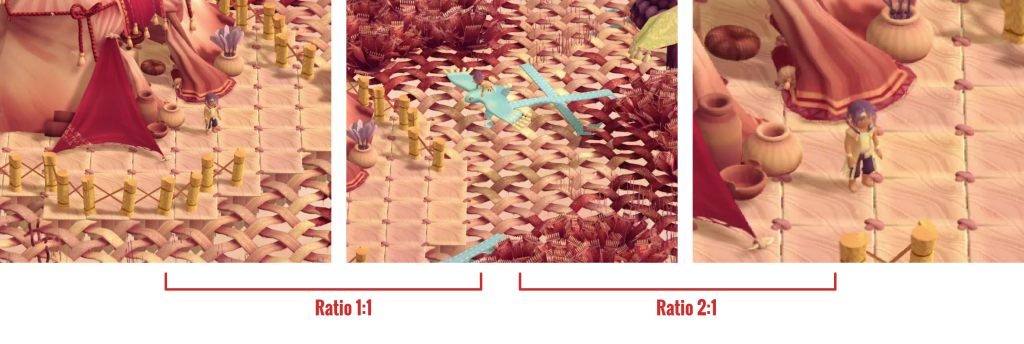One of the main goals of GDKeys is to look at in-development games. Studying big AAA or released games after years of development is extremely valuable but is missing on a major part of game development: iteration, trials & errors, polish, improvements… Looking at in-development games, on the other side, will give us a lot of keys to understand the iterative process of design and how to become better designers ourselves. Based on their prototype and design documents, we will study what works, what doesn’t, what design tricks the team used, what could they improve on, etc.
I want this series to be a very human one: one where each article is the base of a discussion between you, readers, the developers of the game, and myself. Design and creation, in general, are very subjective topics: what I will expose in these articles is my approach, my advice based on my experience, and I really invite you to challenge, improve, back-up or expand on everything I am bringing here. Bring your own voice to the discussion, either in the comments or on Discord.
Also, if you want your own game to be featured on GDKeys, go to the Feature your Game and Ideas page for all the details.

Weaving Tides
Weaving Tides is a lovely adventure game taking place in a textile, woven world. They have a demo out there, a Kickstarter to come, and damn, they have something special! Their main mechanic is a beauty: you are riding weavers ( let’s call them friendly-ribbon-dragons) weaving your way through the world and the story arc. It is used for path-finding, fighting, solving puzzles… So versatile, and so original, this totally won me over!
A good game mechanic is multi-purpose. It empowers your players while tying your world’s pieces together.
Here is how they describe their game:
- Unique weaving gameplay: stitch and cut your way through the textile landscape. Use the weavers’ abilities to wrap up your foes and conquer tricky Zelda-like dungeons and puzzles. Choose the weaver which fits your playstyle and outfit them with mystic embroideries to further enhance their abilities.
- Explore a vibrant woven world: dive into an enchanting, textile landscape and be swept away by the colorful cast of characters with fully hand-painted portraits and the captivating musical score.
- Uncover hidden mysteries packed in a charming story: gather eccentric allies on Tass’ quest to find his parents, assemble fragments of the past and eventually unveil the long-forgotten secrets of the woven world.
- Creative Playground Mode: unlock new, colorful ribbons for your Weavers during the campaign and use them in the playground feature to freely stitch and create your own digital embroidery.
Before we continue, I strongly invite you to check them out and > try out their demo << (opens in a new tab)">>> try out their demo <<
- Website: it even contains a dev blog, talking about creating one of their boss, new mobs and level design generation using their own level editor. Very cool reads!
- Discord
- Steam page
- Facebook page
This game and its current demo actually give us a perfect learning opportunity: we are going to focus this article on the concept of Unique Selling Point, something we should all be considering (even if only to discard it). We will talk about how different games treat it, why is it that important, and then look at the weaving mechanic of Weaving Tides and see how we could push it even further with the help of their 3Cs.
So let’s start with a bit of theory and advice.
Unique Selling Point
The concept of Unique Selling Point (USP) is an interesting angle to consider while developing your game. In short, it is what will differentiate your game from any other on the market. the video-game market is an extremely competitive one: in 2019 alone, more than 8000 games came-out on Steam. If your game wants to have a chance, it will need to stand out in a way and to find its audience. Having and identifying your USP, while not being the magical solution, will clearly help you create a unique product, market your game, and create traction.
This advice is valid for any kind of game (and product): you could be a small dev or a monster AAA company, the question of differentiation will always be a critical one. And the answer can be extremely diverse! It could be anything from:
- A unique art style, Cuphead or Hollow Knight being perfect examples.
- A unique world generation, like what No Man’s Sky succeeded doing after many years of iteration.
- A historical accuracy, looking at you Assassin’s Creed.
- A perfectly tied together world, what made The Witcher 3 and its quests (main and side) so great.
- An insane amount of interconnected systems, like Dwarf Fortress.
- A different approach to story-telling, beautifully done in Disco Elysium.
- Pin-pointed collaboration mechanics, as Overcooked 2 or Lovers in a Dangerous Spacetime succeeded doing.
- …
- And, of course, a very unique gameplay mechanic, like Weaving Tides.
There is one company that mastered the use of this last category over the years: Nintendo. Be it the hat of Mario Odyssey or the Poltergust of Luigi’s Mansion 3, Nintendo always managed to create amazing gameplay mechanics revolving around unique tools. These tools will have a use in every aspect of the game: from platforming to combat, exploration or puzzle-solving moments, they became their games’ key identification point and what will generate unique experience for their players. We could dedicate hours breaking down Nintendo’s game design mastery.

So far, so good: we all identify our USP (or define it), and then we are ready for a unique experience and widely successful game, right? Well, not so fast…
Identifying our USP is giving us a precious piece of information: it tells us where to put our money, resources, and energy. The reality is harsh: we won’t ever make a perfect game. There are just too many aspects to focus on, polish, and refine to be able to address them all. So you will have to prioritize the ones that truly matter, like the USP we just discussed.
Ensure you have the time, resources, energy and talent to make your USP shine. It will be one of the keys of your success.
A very good exercise to do while scoping your game and defining priorities is to take every piece of your game and put them in one of those 4 categories:
- USP: the most important part of your game, where efforts, money and time will be invested.
- Above competition: key components of your game, that will stand-out enough in the player experience and will need to be better than what your competitors are doing.
- Equal to competition: the second layer of priorities. Still need to be strong, do not need to shine.
- Below competition: the less important parts of your game. The ones that you can comfortably leave at an “Ok” level as they aren’t the defining pieces of your experience.
Now… The first time you will do this exercise, you will probably put most of your features in the first 2 categories, and a very small amount in the last one. This is a mistake. It is immensely difficult to develop features that can truly shine above what the market has already (or simply equal it). Even AAA games with years of development and thousands of developers will be very careful in putting any feature in these first 2 categories.
The reality is that the majority of your game will fall in the last category. And it’s ok! Because doing so will actually free you the time and resources to focus on what really matters: your most unique ideas, your gold nuggets, your USP.
I cannot stress this last point enough: your time is limited, your resources are limited, you do not have the talents, time and experience to go head-on against the entire industry on every single one of your features. When working on the biggest year’s AAA games, we had to accept that our story won’t shine, or that our progression system won’t be a new landmark in the video-game landscape, or that our world’s details won’t be what our game will be remembered for. And that’s ok.
Focus on what matters.
The team at Follow the Feathers is making a great job at focusing on their USP. Every video, screenshot, feature, or aspect of their game is tied to their core mechanic: weaving. The world is made of textile landscapes that play a key role in their experience. Their main characters are weavers, magical fabric dragons with the power of weaving through the world. Their special abilities reproduce famous weaving patterns etc.
But the most important part, like the best Nintendo examples I was talking about: their core mechanic ties into every single aspect of their gameplay.
The multiple uses of weaving
After playing the Weaving Tides‘ demo, it is easy to identify the big gameplay pillars around which the game will revolve: exploration/navigation, fighting, and puzzling. Each of these aspects uses the weaving mechanic in an interesting way:
Exploration / Navigation
The main feature that really exploits the specificities of weaving are the 2 layers of navigation: if you are above the fabric ground, you can dive in and out and effectively exploit 2 different layers: layers that come with their own obstacles, enemies, and dangers.

This opens a lot of possibilities in fighting but also gives interesting opportunities in terms of exploration, opening new paths or revealing hidden routes under some more solid ground.
When creating video-games, we take a lot of things for granted, rules we never challenge, like the fact that there is only one ground, one side of our worlds. What opportunities would you open should you break one of them?
Fighting
The fight approach Weaving Tides is taking is pretty straight forward yet can have a lot of depth: killing an enemy will always be done by tying them up (once or multiple times depending on the enemy), but each enemy will have his own specificities: some will follow predefined patterns, some will require to be stunned, by dashing into them, before allowing the player to finish them off. Some, like the boss of the demo, will only have specific weak spots that will reveal after a sequence of attacks.
All in all, enemies and bosses create mini-puzzles, asking the player to figure out how to deal with each of them with the tools he has at his disposal (dash, positioning, special abilities etc.).
This approach is a very solid one under one condition: the game must open new ingredients at a regular pace: new abilities, new environmental elements to use, new enemies, etc. Zelda games are a perfect study should you want a great example of the right pace of new elements’ introduction.
Puzzling

Ribbons weaving is just the perfect mechanic for patterns creation and drawing puzzles. The team at Follow the Feathers understood it and created a variety of puzzles asking the player to reproduce patterns with as many ribbons he wants. While efficient, I am worried this approach won’t allow for enough variety to fill an entire game. The demo has 3 puzzles that are all identical in essence with side variations (mirrored pattern, time-limit, and finding the hidden original).
Here are some extra ideas I would consider: single-ribbon puzzles, asking for continuous threading without the possibility to cut it mid-way; overlapping patterns, asking not only to reproduce the patterns but also to do it in a specific order (and yes I love Celtic-patterns); double-sided patterns, emphasizing the 2 sides of the world and asking the player to solve 2 puzzles in one.
Always make sure your USP can shine through as much as your game aspects as possible.
All in all, Weaving Tides is doing extremely well with their USP scope: it is embedded through every aspect of their game and really gives enough ground to build a full game upon it.
But there is one side of their USP I believe the team at Follow the Feathers still have much to do. Something critical that can make or break a game: the 3Cs.
Camera, controls, character
If you are a Patron of this site, you probably know what I’m referring to when I mention the 3Cs. If you don’t, here is a short summary: the 3Cs, standing for “Camera, Controls, Character”, are the Holy Trinity of your gameplay.

- Camera: the point of view from which your player is watching the game. There are plenty of possibilities, from 1st person, 3rd person, orthographic, perspective, fixed, tracking, etc.
- Controls: the way for your player to interact with your game. Most of the time, his controller and your choice of buttons inputs.
- Character: what makes the character (or object, or whatever) your player controls. His abilities (double jump, dive, dash…) as well as his metrics (running speed, height, jump control amount…)
You NEED to spend a very big amount of time and energy over these. These are what will make your game sharp, enjoyable, responsive, connecting with your players.
Some games even have made their entire USP revolve around how perfect their 3Cs are, like Super Meat Boy.

Now let’s look at Weaving Tides and try to study their 3Cs and refine them to improve their USP.
Camera
Weaving Tides is using a 3rd person, orthographic (understand, without perspective distortion) tracking camera. This is among the most used cameras in adventure games and for plenty of good reasons: it is very easy to set up, contains very few parameters, gives a sense of surroundings, and stay fixed enough so that the controls aren’t impacted by it (remember: if the camera rotates, the controls rotate too!). It is, to me, the best camera set-up to use if you don’t have the expertise or do not want to invest too much energy in it.
Yet, it comes with a very big downside: the impossibility for the player to effectively judge distances. This issue is mainly due to the removal of the perspective and the distant angle but is particularly amplified in Weaving Tides because of their main character: a flying one. This detail creates what is for me the biggest game friction at the moment: not being able to judge the height of the weaver makes it very difficult to plan where will he pass the fabric precisely when he dives or where a ribbon will fall. And this naturally leads to miscalculation, fails and misses.
To counter this issue without changing the camera nor the core system, we could use Signs & Feedback. The solution I’d propose is a very straightforward and non-invasive one: a strong, vertical shadow.

In the example above, it is very difficult to know when the enemy is really under the ribbon and vulnerable. It is also very difficult to assess where will the weaver dive. The shadow answers those 2 problems: the enemy is vulnerable when the shadow covers him, and the tip of the mouth of the weaver (which, on top of that, looks like an arrow!) points to the exact location of the dive.

Talking about cameras, there is an interesting choice made by the team at Follow the Feathers: as you can see from the example above, when the main character dive, the camera point of view does not switch to the bottom part of the world but stays on top of the fabric. They later use that functionality for some blind labyrinth navigation puzzles. This detail is actually important in the player experience: it makes the player an outsider to the story: “I can’t see what the hero is seeing, but I see other things and can guide him” instead of having the player impersonating the hero.
Choices aside, it is very difficult to see the main character through the fabric and judge where to go and where precisely will the weaver go out. I’d consider adding slight transparency (20% to 30% should be enough) to the fabric around the player, when under the world, for better visibility.
Controls
The controls of Weaving Tides are actually very simple and straightforward, at least in their demo: instinctive triggers for the weaving, B to cut a ribbon, A to dash, Y for the special ability… Players’ experience with the genre makes it a no-brainer as our pre-recorded pattern and muscle memory kicks-in.

Character
This part will be a lot more subjective than the other two… There are two things that I was missing much while playing: the sense of progression and mastery, and the feeling of flying a magical dragon.
I live by one of the most famous mantras of good gameplay: “Easy to learn, hard (or impossible) to master”. This sentence dictates that a game should feel instantly intuitive and enjoyable (which is definitely the case here thanks to the controls) but also provides enough depth and subtleties to leave room for improvement even after countless hours spent playing it.
And Weaving Tides isn’t giving me this feeling. The weaver is extremely responsive: I can accelerate to full speed or stop him instantly by pushing or letting go of the trigger, and his flying abilities are extremely scarce: turn left, turn right, move forward, dash, dive up and down.
My advice: bring mastery by making the weaver act as a real flying dragon. Accelerating should take time, decelerating too. turning should be done in a wide arc, mimicking birds and airlift… Bringing complexity in the navigation will create an extremely satisfying learning curve, while also enforcing the fantasy of creating a bond between Tass (the hero) and his weaver. Bonus: different weavers could have different parameters, bringing this feeling of untamed but powerful entities the first time the player starts playing with them.
Finally, to counter-balance the added difficulty, some extra abilities could be added in the move-set of a weaver. Example: a dash while pressing backward would make the weaver do an instant U-turn, a dash while holding a direction would trigger a barrel roll to dodge incoming dangers (new feature: twisting the ribbon?), long-pressing B could act as an instant stop with the weaver flapping strongly its wings, etc.
Not only this would make the player feels more rewarded as he learns to master these moves, but it would also create depth in each of the player’s abilities (dash, cut) and would open opportunities for new enemies.
The more synergies a game has in his systems, the deeper and more cohesive it will become.
Differentiation, Contrast, and Absence
Finally, I’d like to suggest an approach that is a personal favorite of mine: the emphasis by absence. It is something that architects and industrial designers mastered centuries ago through the use of negative space but that very few games considered so far. When we want to highlight something, we add things: extra mechanics, Signs & Feedback, backstory, etc. Very rarely do we emphasize something by pointing out its absence.
And I do believe that a game like Weaving Tides could benefit much from it. Their USP is the promise of riding magical dragons, weaving through the world. We want our hero (and thus our player) to feel powerful, insanely fast, seeing further than they have ever done when riding one!
And the thing is: Tass, the hero, is also spending much time on foot. So what would happen should we remove all that power from him? I would personally play much on that:
- Tass isn’t powerful: a trivial threat for a weaver is a deadly danger for him! Reuse enemies from different points of view.
- Tass isn’t fast: let’s make him much slower than a weaver (and a lot more controllable as he is not flying)
- Tass isn’t tall: let’s cut in half the field of view of the camera when on foot.

Doing that would create a strong duality between the hero and the weavers, reinforcing their bond. It would instantly make the player feel weak or almighty thanks to gameplay differentiation. It would give a human, more connecting side to the player on foot, perfect for world-building and narration.
Extra: adding constraints to the weaver (like the impossibility to navigate small passages or fly over solid ground) would also empower the hero and push the idea that the only way to succeed is by teaming-up and that Tass is powerful too, in his own way.
I highly recommend you to play Brothers: a Tale of Two Sons if you want an extremely powerful example of that concept in action.

Key takeaway
Should you remember only few bits from this article, make them the followings:
- Identify your USP, make sure you have the talent, time, and resources to ship it at its absolute best and make it at the top of your list of priorities.
- Polish your 3Cs, over and over again. They are the connection between your players and your game and will play a critical role in the player experience (particularly if your 3Cs impact you USP).
- Instead of always giving more to your players, consider removing things too. Or adding friction. Smartly done and it will make wonders.
And finally: go support Weaving Tides and the team at Follow the Feathers! They are doing an amazing job, their Kickstarter is on its way, and I personally can’t wait to weave through their world.
Do you want to get regular quality articles on Game Design? Join an awesome community of devs and designers on our private Discord to discuss articles and design in general? Then consider supporting GDKeys, for as low as 1$.

Share your Experience